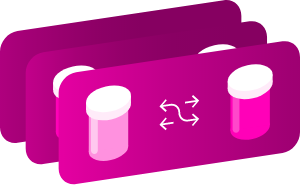Identification
- Summary
-
Propanoic acidis an antimicrobial food additive.
- Generic Name
- Propanoic acid
- DrugBank Accession Number
- DB03766
- Background
-
丙酸钠是丙的钠盐acid that exists as colorless, transparent crystals or a granular crystalline powder. It is considered generally recognized as safe (GRAS) food ingredient by FDA, where it acts as an antimicrobial agent for food preservation and flavoring agent. Its use as a food additive is also approved in Europe. Sodium propionate is is prepared by neutralizing propionic acid with sodium hydroxide. Sodium propionate was previously approved in Canada as an active ingredient in Amino-Cerv (used to treat inflammation or injury of the cervix).
- Type
- Small Molecule
- Groups
- Approved, Vet approved
- Structure
- Weight
-
Average: 74.0785
Monoisotopic: 74.036779436 - Chemical Formula
- C3H6O2
- Synonyms
-
- Propionic acid
- External IDs
-
- E-280
- FEMA NO. 2924
- INS NO.280
- INS-280
Pharmacology
- Indication
-
Propanoic acid and various direct sodium or calcium salt formulations of the acid are currently most commonly approved and indicated by organizations like the FDA and EMA for use as an antibacterial food additive preservative in animal feed and food for human consumption5,6.
Similarly, although the use of propanoic acid or any of its direct sodium or calcium salt formulations as excipient ingredients in pharmaceuticals is not necessarily a major role for the compound today, sodium propionate was used in some vaginal cream preparations indicated for cervicitis, cervical tears, and/or postcauterization, postcryosurgery, and postconization of the cervix3.In such products, the sodium propionate was primarily used to elicit a preservative, bacteriostatic4,11effect while other active ingredients combined in the formulation like urea, benzalkonium chloride, inositol, and methionine and cystine amino acids facilitated debridement, enhanced medication spread, epithelialization promotion, and wound healing, respectively4,1.
Nevertheless, a great variety of propionic acid derivatives exist as separate pharmaceuticals, each with their own unique therapeutic categories, pharmacodynamics, and pharmacokinetics.
 Reduce drug development failure ratesBuild, train, & validate machine-learning models
Reduce drug development failure ratesBuild, train, & validate machine-learning models
with evidence-based and structured datasets.Build, train, & validate predictive machine-learning models with structured datasets. - Contraindications & Blackbox Warnings
-
 Avoid life-threatening adverse drug eventsImprove clinical decision support with information oncontraindications & blackbox warnings, population restrictions, harmful risks, & more.Avoid life-threatening adverse drug events & improve clinical decision support.
Avoid life-threatening adverse drug eventsImprove clinical decision support with information oncontraindications & blackbox warnings, population restrictions, harmful risks, & more.Avoid life-threatening adverse drug events & improve clinical decision support. - Pharmacodynamics
-
As a naturally occurring carboxylic acid, propionic acid typically undergoes metabolism via conversion to propionyl coenzyme A (propionyl-CoA), which is part of the usual metabolic pathway that carboxylic acids participate within in the human body2,7.Most of propionic acid's antibacterial and preservative activities subsequently stem from this metabolic pathway as the metabolic fate of propionates varies in different microorganisms, resulting in antimicrobial mechanisms of action that may revolve around differing propionate metabolites causing competition, inhibition, and/or interference effects along other metabolic pathways in the various microorganisms affected7.
In the human body, however, propionic acid is generally metabolized with little ill effect and ultimately becomes a chemical intermediate in the citric acid cycle7.
- Mechanism of action
-
The metabolic fate of propionates varies in different microorganisms7.Some have enzyme systems that can convert succinate to propionyl-coenzyme A and through various further steps to propionate, CO2, or propionyl phoshpate7.Still others can convert propionic acid to B-alanine or directly to CO27.Whatever the case, the inhibiting effect for microbials is likely related to competition with acetate in the acetokinase system, to the blockage of pyruvate conversion to acetyl-coenzyme A and to interference with B-alanine in pantothenic acid syntheses7.
Moreover, other studies suggest the antimicrobial activity of propionic acid revolves around its ability to reduce the pH of its immediate environment to levels of acidity that are harmful to pathogenic microbes as well as its ability to dissociate such that its lipid soluble undissociated form is capable of entering microbial cells8.此外,也有研究的措施t that propionic acid's antifungal activity may be the result of propionyl-CoA inhibiting glucose metabolism in certain species of fungus via the accumulation of the CoA-derivative2.
Target Actions Organism UAlanine racemase Not Available Geobacillus stearothermophilus UGephyrin Not Available Humans U2-hydroxy-6-oxo-7-methylocta-2,4-dienoate hydrolase Not Available Pseudomonas fluorescens - Absorption
-
Some propionic acid is oxidized to lactic acid during absorption, but most passes to the liver, which removes nearly all of it from the portal blood9.Propionic acid represents 20-25% of absorbed volatile fatty acids9.
Propionic acid is rapidly absorbed through the gastrointestinal tract9.
- Volume of distribution
-
三天后的单一口服labeled sodium propionate, 77% of the radioactivity was found in expired air, and 7% in urine and feces9.The radioactivity found in skin, liver, intestine, and adipose tissue was 3.9, 1.1, 0.9, and 0.7%, respectively9.
Readily accessible data regarding the volume of distribution of propionic acid is not available.
- Protein binding
-
Readily accessible data regarding the protein binding of propionic acid is not available.
- Metabolism
-
Propionic acid is first converted to propionyl coenzyme A (propionyl-CoA), however, it directly enter either beta oxidation or the citric acid cycles7.As propionic acid has three carbons, propionyl-CoA7.In the majority of vertebrates, propionyl-CoA is carboxylated to D-methylmalonyl-CoA, which is then isomerised to L-methylmalonyl-CoA7.A vitamin B12-dependent enzyme catalyzes rearrangement of L-methylmalonyl-CoA to succinyl-CoA, which can then be used as a substrate in the citric acid cycle7.
Hover over products below to view reaction partners
- Route of elimination
-
Most absorbed propionic acid is passed to the liver, which removes nearly all of it from the portal blood9.
三天后的单一口服labeled sodium propionate, 77% of the radioactivity was found in expired air, and 7% in urine and feces9.
- Half-life
-
The half-life of iv sodium propionate administered in the sheep animal model is about 6.9 +/- 0.4 minutes9.
- Clearance
-
Readily accessible data regarding the clearance of propionic acid is not available.
- Adverse Effects
-
 Improve decision support & research outcomesWith structured adverse effects data, including:blackbox warnings, adverse reactions, warning & precautions, & incidence rates.Improve decision support & research outcomes with our structured adverse effects data.
Improve decision support & research outcomesWith structured adverse effects data, including:blackbox warnings, adverse reactions, warning & precautions, & incidence rates.Improve decision support & research outcomes with our structured adverse effects data. - Toxicity
-
As a compound that is typically found naturally in the body, little to no adverse cumulative health effects have been associated with exposure to propionic acid10.Medical reports of acute exposures of workers to propionic acid show mild to moderate skin burns, mild eye redness, and one case of a mild cough and asthmatic response10.
- Pathways
-
Pathway Category Propanoate Metabolism Metabolic Malonic Aciduria Disease Methylmalonic Aciduria Due to Cobalamin-Related Disorders Disease Vitamin K Metabolism Metabolic Malonyl-CoA Decarboxylase Deficiency Disease - Pharmacogenomic Effects/ADRsBrowse all" title="" id="snp-actions-info" class="drug-info-popup" href="javascript:void(0);">
- Not Available
Interactions
- Drug InteractionsLearn More" title="" id="structured-interactions-info" class="drug-info-popup" href="javascript:void(0);">
-
This information should not be interpreted without the help of a healthcare provider. If you believe you are experiencing an interaction, contact a healthcare provider immediately. The absence of an interaction does not necessarily mean no interactions exist.Not Available
- Food Interactions
- No interactions found.
Products
-
 Drug product information from 10+ global regionsOur datasets provide approved product information including:
Drug product information from 10+ global regionsOur datasets provide approved product information including:
dosage, form, labeller, route of administration, and marketing period.Access drug product information from over 10 global regions. - Product Ingredients
-
Ingredient UNII CAS InChI Key Sodium propionate DK6Y9P42IN 6700-17-0 HOAUAOBUGFYWMK-UHFFFAOYSA-M - Mixture Products
-
Name Ingredients Dosage Route Labeller Marketing Start Marketing End Region Image Amino-cerv Sodium propionate(0.50 %)+Cystine(0.354 %)+Inositol(0.83 %)+Racemethionine(0.83 %)+Urea(8.34 %) Cream Vaginal Milex, A Coopersurgical Co. 1952-12-31 2007-07-26 Canada
Categories
- ATC Codes
- S01AX10 — Sodium propionate
- Drug Categories
- Chemical TaxonomyProvided byClassyfire
-
- Description
- This compound belongs to the class of organic compounds known as carboxylic acids. These are compounds containing a carboxylic acid group with the formula -C(=O)OH.
- Kingdom
- Organic compounds
- Super Class
- Organic acids and derivatives
- Class
- Carboxylic acids and derivatives
- Sub Class
- Carboxylic acids
- Direct Parent
- Carboxylic acids
- Alternative Parents
- Monocarboxylic acids and derivatives/Organic oxides/Hydrocarbon derivatives/Carbonyl compounds
- Substituents
- Aliphatic acyclic compound/Carbonyl group/Carboxylic acid/Hydrocarbon derivative/Monocarboxylic acid or derivatives/Organic oxide/Organic oxygen compound/Organooxygen compound
- Molecular Framework
- Aliphatic acyclic compounds
- External Descriptors
- saturated fatty acid, short-chain fatty acid (CHEBI:30768)/Straight chain fatty acids, Saturated fatty acids (C00163)/Straight chain fatty acids (LMFA01010003)
- Affected organisms
-
- Humans and other mammals
Chemical Identifiers
- UNII
- JHU490RVYR
- CAS number
- 79-09-4
- InChI Key
- XBDQKXXYIPTUBI-UHFFFAOYSA-N
- InChI
-
InChI=1S/C3H6O2/c1-2-3(4)5/h2H2,1H3,(H,4,5)
- IUPAC Name
-
propanoic acid
- SMILES
-
CCC(O)=O
References
- Synthesis Reference
-
James R. Hazen, "Process for production of 3-(hydroxyphenylphosphinyl)-propanoic acid." U.S. Patent US4769182, issued March, 1978.
US4769182 - General References
-
- Ilic L, Gowrishankar TR, Vaughan TE, Herndon TO, Weaver JC: Spatially constrained skin electroporation with sodium thiosulfate and urea creates transdermal microconduits. J Control Release. 1999 Aug 27;61(1-2):185-202. [Article]
- 布洛克M,上W: t的作用机制he antifungal agent propionate. Eur J Biochem. 2004 Aug;271(15):3227-41. doi: 10.1111/j.1432-1033.2004.04255.x. [Article]
- Leonard G. Gomella, Steven A. Haist, Steven Haist (2003). Clinician's Pocket Drug Reference 2004 (3rd ed.). McGraw-Hill/Appleton & Lange. [ISBN:978-0071429450]
- RXmed.com: AMINO-CERV Monograph [Link]
- FDA Listing of Propionic Acid [Link]
- EFSA Journal: Safety of the extension of use of sodium propionate (E 281) as a food additive [Link]
- INCHEM Propionic Acid and its Calcium, Potassium, and Sodium Salts (WHO Food Additive Series 5) [Link]
- PROPIONIC ACID IS AN ALTERNATIVE TO ANTIBIOTICS IN POULTRY DIET [Link]
- PubChem Propionic Acid Profile [Link]
- NIH Toxnet: Propionic Acid Profile [Link]
- Compendium of Pharmaceutical Excipients for Vaginal Formulations [File]
- External Links
-
- Human Metabolome Database
- HMDB0000237
- KEGG Drug
- D02310
- KEGG Compound
- C00163
- PubChem Compound
- 1032
- PubChem Substance
- 46508742
- ChemSpider
- 1005
- BindingDB
- 50082199
- 34658
- ChEBI
- 30768
- ChEMBL
- CHEMBL14021
- ZINC
- ZINC000006050663
- Guide to Pharmacology
- GtP Drug Page
- PDBe Ligand
- PPI
- Wikipedia
- Propionic_acid
- PDB Entries
- 1a8s/1adl/1lic/1lie/1seg/1tu9/1uk6/1uux/1uuy/2hub… show 42 more
- MSDS
-
Download (62.7 KB)
Clinical Trials
- Clinical TrialsLearn More" title="" id="clinical-trials-info" class="drug-info-popup" href="javascript:void(0);">
-
Phase Status Purpose Conditions Count 1, 2 Not Yet Recruiting Treatment Radiation Toxicity/Therapeutic Agent Toxicity 1
Pharmacoeconomics
- Manufacturers
-
Not Available
- Packagers
-
Not Available
- Dosage Forms
-
Form Route Strength Cream Vaginal Mouthwash Buccal 0.25 % - Prices
- Not Available
- Patents
- Not Available
Properties
- State
- Solid
- Experimental Properties
-
Property Value Source melting point (°C) -20.7 °C PhysProp boiling point (°C) 141.1 °C PhysProp water solubility 1E+006 mg/L (at 25 °C) US EPA (1981) logP 0.33 HANSCH,C ET AL. (1995) pKa 4.88 SERJEANT,EP & DEMPSEY,B (1979) - Predicted Properties
-
Property Value Source Water Solubility 352.0 mg/mL ALOGPS logP 0.31 ALOGPS logP 0.48 ChemAxon logS 0.68 ALOGPS pKa (Strongest Acidic) 4.75 ChemAxon Physiological Charge -1 ChemAxon Hydrogen Acceptor Count 2 ChemAxon Hydrogen Donor Count 1 ChemAxon Polar Surface Area 37.3 Å2 ChemAxon Rotatable Bond Count 1 ChemAxon Refractivity 17.27 m3·mol-1 ChemAxon Polarizability 7.24 Å3 ChemAxon Number of Rings 0 ChemAxon Bioavailability 1 ChemAxon Rule of Five Yes ChemAxon Ghose Filter No ChemAxon Veber's Rule Yes ChemAxon MDDR-like Rule No ChemAxon - Predicted ADMET Features
-
Property Value Probability Human Intestinal Absorption + 0.9893 Blood Brain Barrier + 0.941 Caco-2 permeable + 0.6324 P-glycoprotein substrate Non-substrate 0.7959 P-glycoprotein inhibitor I Non-inhibitor 0.9671 P-glycoprotein inhibitor II Non-inhibitor 0.9909 Renal organic cation transporter Non-inhibitor 0.9624 CYP450 2C9 substrate Non-substrate 0.788 CYP450 2D6 substrate Non-substrate 0.9394 CYP450 3A4 substrate Non-substrate 0.8006 CYP450 1A2 substrate Non-inhibitor 0.8922 CYP450 2C9 inhibitor Non-inhibitor 0.9639 CYP450 2D6 inhibitor Non-inhibitor 0.9667 CYP450 2C19 inhibitor Non-inhibitor 0.9794 CYP450 3A4 inhibitor Non-inhibitor 0.9763 CYP450 inhibitory promiscuity Low CYP Inhibitory Promiscuity 0.9876 Ames test Non AMES toxic 0.9401 Carcinogenicity Carcinogens 0.6548 Biodegradation Ready biodegradable 0.9079 Rat acute toxicity 1.4864 LD50, mol/kg Not applicable hERG inhibition (predictor I) Weak inhibitor 0.9681 hERG inhibition (predictor II) Non-inhibitor 0.9778
Spectra
- Mass Spec (NIST)
- Not Available
- Spectra
Targets

insights and accelerate drug research.
- Kind
- Protein
- Organism
- Geobacillus stearothermophilus
- Pharmacological action
-
Unknown
- General Function
- Pyridoxal phosphate binding
- Specific Function
- Catalyzes the interconversion of L-alanine and D-alanine. Also weakly active on serine.
- Gene Name
- alr
- Uniprot ID
- P10724
- Uniprot Name
- Alanine racemase
- 分子量
- 43592.715 Da
References
- Morollo AA,宠物sko GA, Ringe D: Structure of a Michaelis complex analogue: propionate binds in the substrate carboxylate site of alanine racemase. Biochemistry. 1999 Mar 16;38(11):3293-301. [Article]
- Kind
- Protein
- Organism
- Humans
- Pharmacological action
-
Unknown
- General Function
- Molybdopterin molybdotransferase activity
- Specific Function
- Microtubule-associated protein involved in membrane protein-cytoskeleton interactions. It is thought to anchor the inhibitory glycine receptor (GLYR) to subsynaptic microtubules (By similarity). Ca...
- Gene Name
- GPHN
- Uniprot ID
- Q9NQX3
- Uniprot Name
- Gephyrin
- 分子量
- 79747.635 Da
References
- Berman HM, Westbrook J, Feng Z, Gilliland G, Bhat TN, Weissig H, Shindyalov IN, Bourne PE: The Protein Data Bank. Nucleic Acids Res. 2000 Jan 1;28(1):235-42. [Article]
- Kind
- Protein
- Organism
- Pseudomonas fluorescens
- Pharmacological action
-
Unknown
- General Function
- Hydrolase activity
- Specific Function
- Not Available
- Gene Name
- cumD
- Uniprot ID
- P96965
- Uniprot Name
- 2-hydroxy-6-oxo-7-methylocta-2,4-dienoate hydrolase
- 分子量
- 31489.385 Da
Enzymes
- Kind
- Protein group
- Organism
- Humans
- Pharmacological action
-
Unknown
- Actions
-
Inhibitor
- General Function
- Transcription regulatory region sequence-specific dna binding
- Specific Function
- Responsible for the deacetylation of lysine residues on the N-terminal part of the core histones (H2A, H2B, H3 and H4). Histone deacetylation gives a tag for epigenetic repression and plays an impo...
Components:
References
- Ganapathy V, Thangaraju M, Gopal E, Martin PM, Itagaki S, Miyauchi S, Prasad PD: Sodium-coupled monocarboxylate transporters in normal tissues and in cancer. AAPS J. 2008;10(1):193-9. doi: 10.1208/s12248-008-9022-y. Epub 2008 Apr 2. [Article]
Carriers
- Kind
- Protein
- Organism
- Humans
- Pharmacological action
-
Unknown
- General Function
- Transporter activity
- Specific Function
- Lipid transport protein in adipocytes. Binds both long chain fatty acids and retinoic acid. Delivers long-chain fatty acids and retinoic acid to their cognate receptors in the nucleus (By similarity).
- Gene Name
- FABP4
- Uniprot ID
- P15090
- Uniprot Name
- Fatty acid-binding protein, adipocyte
- 分子量
- 14718.815 Da
References
- Overington JP, Al-Lazikani B, Hopkins AL: How many drug targets are there? Nat Rev Drug Discov. 2006 Dec;5(12):993-6. [Article]
- Imming P, Sinning C, Meyer A: Drugs, their targets and the nature and number of drug targets. Nat Rev Drug Discov. 2006 Oct;5(10):821-34. [Article]
- Berman HM, Westbrook J, Feng Z, Gilliland G, Bhat TN, Weissig H, Shindyalov IN, Bourne PE: The Protein Data Bank. Nucleic Acids Res. 2000 Jan 1;28(1):235-42. [Article]
Drug created at June 13, 2005 13:24 / Updated at April 30, 2021 13:05




